Previously, an "industry chain panorama of 18 industries" had been filled with friends. Many WeChat public accountants have made a lot of traffic and have also gained a lot of fans. In this article, it is natural that there is a panorama of the industry chain of the most popular robot industry at the moment (see the figure below). The contents are very comprehensive, and indeed people have gained a lot of knowledge.
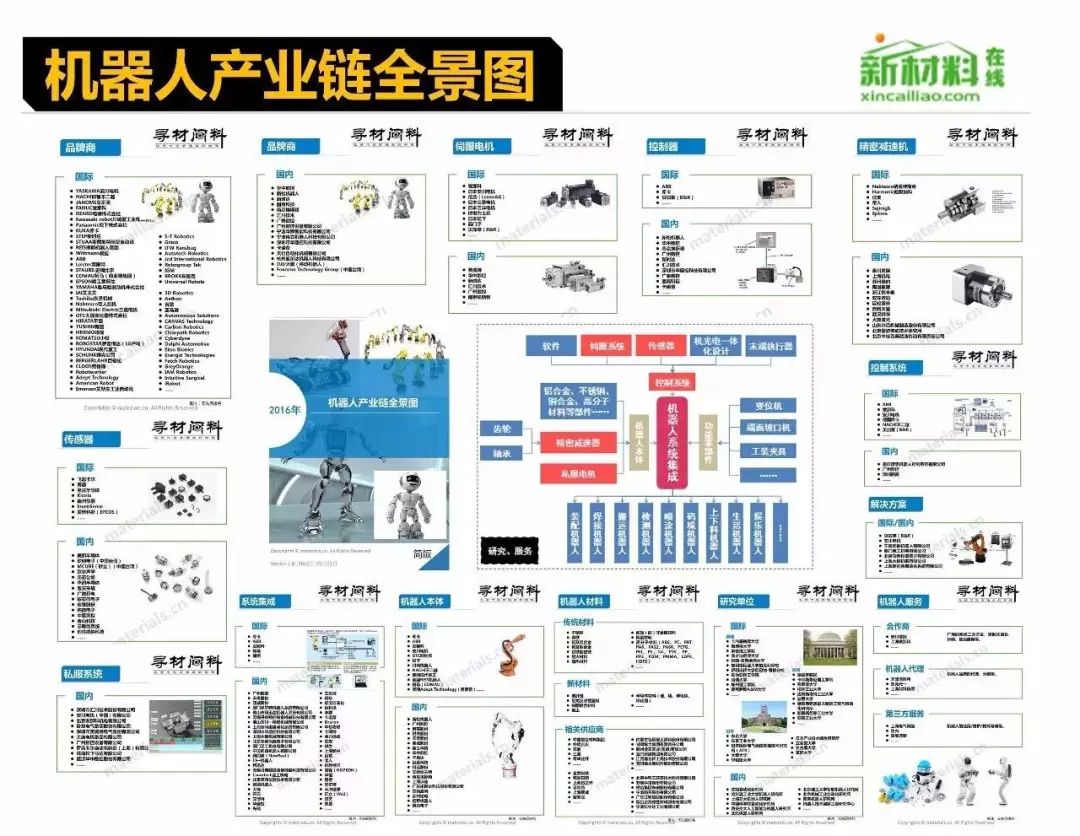

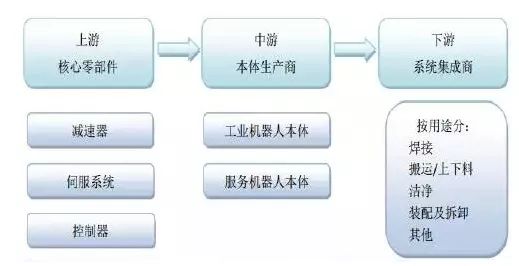
# Core components
reducer
According to different structures, precision reducers for industrial robots can be divided into five categories. RV reducers and harmonic reducers are the most popular precision reducers for industrial robots. Precision reducer according to the different structure, can be divided into harmonic gear reducer, cycloid planetary reducer, RV reducer, precision planetary reducer and filter gear reducer five categories. Each of the performance indicators of the reducer, such as accuracy, torque, stiffness, and transmission efficiency, are different. Among them, RV reducer and harmonic reducer are the most popular precision reducers for industrial robots.
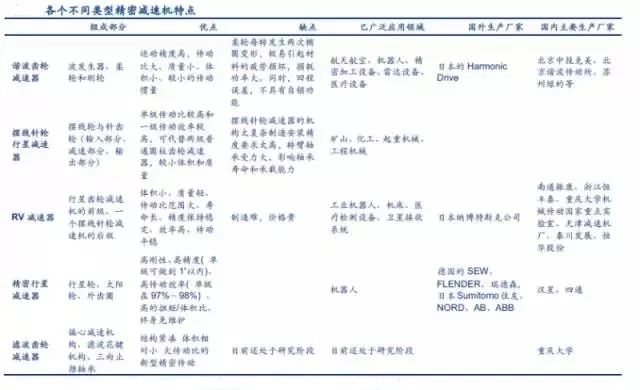
RV reducers, which account for approximately 60% of the market, HamonicaDrive produces harmonic reducers, which account for approximately 15% of the market. Compared to the accumulation of Japanese giants for decades, China's industrial robots used precision reducers to start late, and the technology was not mature, which created a situation where precision reducers could not be self-sufficient, and relied heavily on imports. Domestic companies involved in RV precision reducers include listed companies Qinchuan Machine Tool, Shanghai Mechatronics Co., Ltd. and Juhuan Co., Ltd. The Xinsanban Co., Ltd. has the sole target of Henghua Co., Ltd. The non-listed companies include Nantong Zhenkang, Hengfengtai, Wuhan Essence, Shanghai Essence, and Shandong. Shuai Ke, etc., involved non-listed harmonic gear reducer Suzhou Green Harmonics Drive Technology Co., Ltd., Beijing Zhongji Meike Harmonic Drive Co., Ltd. and so on.
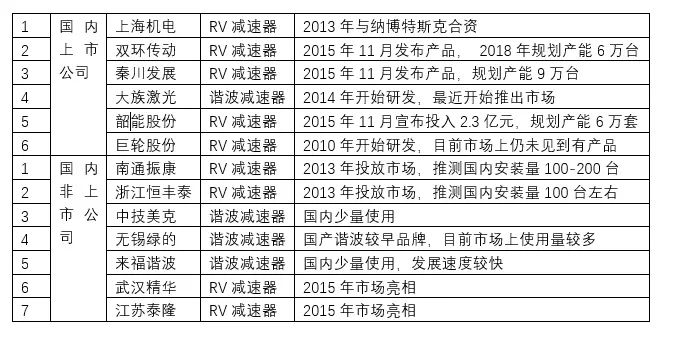
servo motor
Robots have very strict requirements on joint drive motors, and AC servo motors are widely used in industrial robots. At present, the domestic high-end market is mainly occupied by foreign famous enterprises, mainly from Japan and Europe and the United States, and there is a large space for domestic substitution in the future. At present, foreign brands occupy nearly 80% of the market share of China's AC servo market, mainly from Japan, Europe and the United States. Among them, Japanese products rank first in the market with about 50% of the market. Its famous brands include Panasonic, Mitsubishi Electric, Yaskawa, Sanyo, and Fujitsu. Its products are characterized by a level of technology and performance that is in line with the needs of Chinese users, with a good price/performance ratio. The higher reliability has resulted in a stable and continuous customer source, which has a monopoly advantage in the small and medium-sized OEM market. In the next five years, China's servo system industry will benefit from the impact of industrial upgrading and will maintain a rapid growth. Domestic alternative space is still large. The larger servo brand market in China includes the listed companies Eston, Huichuan Technology, Huazhong CNC, Guangzhou CNC, Lishi, Xinshida and Xinsanban Company Beichao Servo. Among them, the servo motor and the numerical control system provided by the Inovance technology basically achieved self-sufficiency. In the new time, some models of the Eston robot started to use the self-developed controller and servo system. The North Super servo can provide the motor and Drive integration products.
Controller
The software part of the robot controller is the "heart" of the industrial robot. With the development of science and technology, the industrial robot has different degrees of research results from the lower computer to the application software of the upper computer. Controllers, software, and ontology are generally independently designed and developed by robot manufacturers. At present, the controllers of foreign mainstream robot manufacturers all carry out independent research and development on the basis of a common multi-axis motion controller platform. Each brand robot has its own control system to match. Therefore, the market share of the controller is basically the same as that of the robot, and the domestic enterprise controller has not yet formed a competitive advantage in the market. The domestic enterprise robot controller products have matured and are the key components that have the smallest gap between robot products and foreign products. The gap between domestic controllers and foreign products is mainly in the control algorithm and ease of use of the secondary development platform. In the next few years, Chinese domestic robots will develop rapidly, and the domestic robot controller application market will face relatively good opportunities for development, especially in the field of motion control. The more robot axes, the higher the controller performance requirements: the degree of freedom of the robot depends on the number of joints it can move. The more joints, the higher the degree of freedom, the higher the displacement accuracy. The number of servo motors is relatively large, that is, the more precision industrial robots use more servo motors. In general, each multi-axis robot is controlled by a set of control systems, which also means that the controller performance requirements are higher. With the rapid development of Chinese industrial robots, companies with strong R&D capabilities will have stronger competitive advantages.
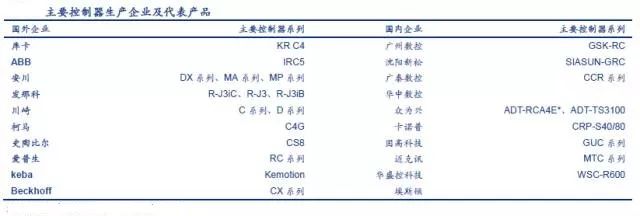
Industrial robots Since the birth of the first industrial robot in 1958, the development of robots has experienced a small upsurge. By the late 1980s, due to the saturation of traditional robot users' industrial robots, the backlog of industrial robots has caused many robots. Manufacturers collapsed or merged, and international robotics research and robotics industry showed a downturn. By the early 1990s, the robotics industry showed signs of recovery and continued development. After 1995, the number of robots in the world increased year by year, and the growth rate was also high. Since the global financial turmoil, the recovery of the market has brought about a recovery in the robotics industry. The growth trend of the global robotics industry has continued, and the market scale has continued to expand. Governments and multinational corporations have been actively investing in the robotics industry. In 2016, the global orders for industrial robots were 258,900 units, with 1779,000 units in stock, 85,000 units in China, and 332,300 units in stock.
Although we have become the world’s largest robot sales market for many years, it is undeniable that foreign brands account for more than 60% of the Chinese industrial robot market; as for multi-joint robots with more than six axes, the market share occupied by foreign brands is even higher. Bigger, more than 80%. Foreign brands occupy an absolute advantage in the high-end multi-joint robot market. In addition to the four big families we know, ABB, Kuka, Yaskawa, and Fanuc, there are many second and third tier brands:
Epson, Kawasaki, Adept, RethinkRobotics, You proud robots, Comau, Panasonic, OTC, Nachi Fujimoto, Denso, Stäubli, Hyundai Heavy Industries, Mitsubishi Electric, and of course, domestic brands have also begun to gradually rise, among which the new loose robot can be described as Well-deserved leading enterprises, in addition: Xinshida, Eft, Guangzhou CNC, Huazhong CNC... In the field of AGV, the technical difference between domestic and foreign products is not very large, domestic brands are still very competitive In addition to Xinsong Robot, Jiateng Robots is also a representative brand, and its products have won the German Red Dot Design Award. The domestically produced AGV brand also includes Kun Ship, Beijing Machine Science Development, National Robots, Huaxiao Precision, Guangzhou Yuanneng, Changsha Chizhong, Guangzhou Jingyuan, Jiashun Smart, and Oukai Robot.
The application of foreign products in the field of logistics has been very successful. Typical representatives are the Kiva System acquired by Amazon, and of course they are: Fetch Robotics, Aethon, CANVAS Technology, Swisslog, Gray Orange, ......... System integrators only robots bare metal can not Any work needs to be completed through system integration before it can be used by end customers. The solution of the system integration solution is based on the downstream application of the robot industry chain. It provides application solutions for end customers and is responsible for the development and integration of industrial robot software systems. It is an important component of industrial robots' automatic operations. According to industry sources, at present, in the field of industrial robotics in China, the system integrator is basically left to make money.
In China, system integrators mostly purchase robots from abroad, and according to the needs of different industries or customers, formulate solutions that meet the needs of production. Robot system integrators, as the main force in the Chinese robot market, are generally small in scale, have low annual output value and face strong competitive pressures. Judging from relevant market data, at present, the scale of domestic integrators is not large, and companies with sales revenue below 100 million account for the majority. Those who can achieve 50 million yuan are the best in the industry, and those with more than 10 billion yuan are nationwide. countable. As the price of hardware products has been declining year by year and profits have become thinner and thinner, the sales model of hardware products driven by projects alone has become the past. At the same time, the threshold for entering the field of system integration has become lower and the competition has become more intense. The barriers to system integration are relatively low, and the bargaining power between the upper and lower reaches is weak, and the level of gross profit is not high, but the market size is far greater than that of the ontology market.
. International robot system integration companies mainly include KUKA, ABB, Fanuc, Coma, and Muse. Domestic companies involved in the downstream integrated applications mainly include Xinsong Robot, Boss shares, Tianqi shares, Guangzhou CNC, Estun, Xiamen Sierte, Tangshan Kaiyuan, Kunshan Huaheng, Foshan Lixun, Bossi automation, Suzhou Beiren, Hualu Automation, Shangyu Automation, Handy Robot, Rurmamart, Nanjing Panda, Hangzhou Woradi, Shenzhen Leibo, Bronte, Linkman, Topstar, and Teda robots.
Background Frame,Photography Backdrop,Photo Studio Background,Photography Studio Backdrop
SHAOXING SHANGYU FEIXIANG PHOTOGRAPHIC CO.,LTD , https://www.flying-photography.com